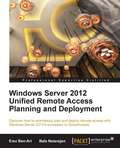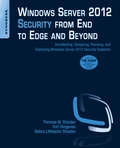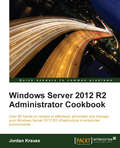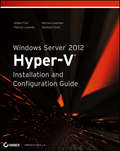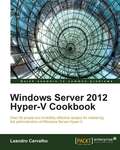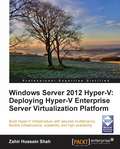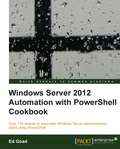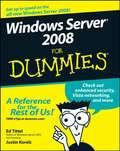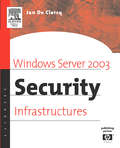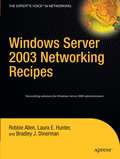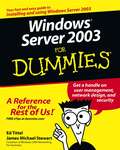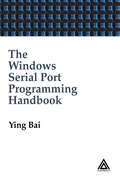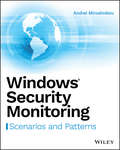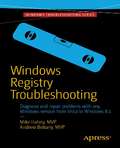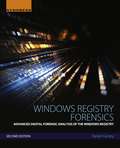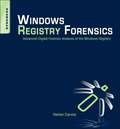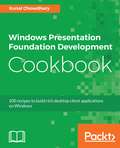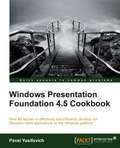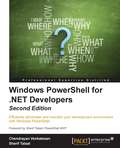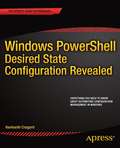- Table View
- List View
Windows Server 2012 Unified Remote Access Planning and Deployment
by Erez Ben-Ari Bala Natarajan"Windows Server 2012 Unified Remote Access Planning and Deployment" is a quick start tutorial full of step-by-step instructions to guide you through planning and deploying Unified Remote Access; the successor to DirectAccess. If you are a System Administrator or Engineer who has strong knowledge of networking and deployment for the Microsoft family of operating systems and software, then "Windows Server 2012 Unified Remote Access Planning and Deployment" is for you. You should have a sound understanding of TCP/IP networking, as well as deploying and supporting Windows Server and Client operating systems.
Windows Server 2012 Security from End to Edge and Beyond: Architecting, Designing, Planning, and Deploying Windows Server 2012 Security Solutions
by Yuri Diogenes Thomas W Shinder Debra Littlejohn ShinderWindows Server 2012 Security from End to Edge and Beyond shows you how to architect, design, plan, and deploy Microsoft security technologies for Windows 8/Server 2012 in the enterprise. The book covers security technologies that apply to both client and server and enables you to identify and deploy Windows 8 security features in your systems based on different business and deployment scenarios. The book is a single source for learning how to secure Windows 8 in many systems, including core, endpoint, and anywhere access. Authors Tom Shinder and Yuri Diogenes, both Microsoft employees, bring you insider knowledge of the Windows 8 platform, discussing how to deploy Windows security technologies effectively in both the traditional datacenter and in new cloud-based solutions. With this book, you will understand the conceptual underpinnings of Windows 8 security and how to deploy these features in a test lab and in pilot and production environments. The book's revolutionary "Test Lab Guide" approach lets you test every subject in a predefined test lab environment. This, combined with conceptual and deployment guidance, enables you to understand the technologies and move from lab to production faster than ever before. Critical material is also presented in key concepts and scenario-based approaches to evaluation, planning, deployment, and management. Videos illustrating the functionality in the Test Lab can be downloaded from the authors’ blog http://blogs.technet.com.b.security_talk/. Each chapter wraps up with a bullet list summary of key concepts discussed in the chapter.Provides practical examples of how to design and deploy a world-class security infrastructure to protect both Windows 8 and non-Microsoft assets on your systemWritten by two Microsoft employees who provide an inside look at the security features of Windows 8 Test Lab Guides enable you to test everything before deploying live to your system
Windows Server 2012 R2 Administrator Cookbook
by Jordan KrauseThis book is intended for system administrators and IT professionals with experience in Windows Server 2008 or Windows Server 2012 environments who are looking to acquire the skills and knowledge necessary to manage and maintain the core infrastructure required for a Windows Server 2012 and Windows Server 2012 R2 environment.
Windows Server 2012 Hyper-V Installation and Configuration Guide
by Aidan Finn Patrick Lownds Michel Luescher Damian FlynnGo-to guide for using Microsoft's updated Hyper-V as a virtualization solution Windows Server 2012 Hyper-V offers greater scalability, new components, and more options than ever before for large enterprise systems and small/medium businesses. Windows Server 2012 Hyper-V Installation and Configuration Guide is the place to start learning about this new cloud operating system. You'll get up to speed on the architecture, basic deployment and upgrading, creating virtual workloads, designing and implementing advanced network architectures, creating multitenant clouds, backup, disaster recovery, and more. The international team of expert authors offers deep technical detail, as well as hands-on exercises and plenty of real-world scenarios, so you thoroughly understand all features and how best to use them. Explains how to deploy, use, manage, and maintain the Windows Server 2012 Hyper-V virtualization solutions in large enterprises and small- to medium-businesses Provides deep technical detail and plenty of exercises showing you how to work with Hyper-V in real-world settings Shows you how to quickly configure Hyper-V from the GUI and use PowerShell to script and automate common tasks Covers deploying Hyper-V hosts, managing virtual machines, network fabrics, cloud computing, and using file servers Also explores virtual SAN storage, creating guest clusters, backup and disaster recovery, using Hyper-V for Virtual Desktop Infrastructure (VDI), and other topics Help make your Hyper-V virtualization solution a success with Windows Server 2012 Hyper-V Installation and Configuration Guide.
Windows Server 2012 Hyper-V Installation and Configuration Guide
by Aidan Finn Patrick Lownds Michel Luescher Damian FlynnGo-to guide for using Microsoft's updated Hyper-V as a virtualization solution Windows Server 2012 Hyper-V offers greater scalability, new components, and more options than ever before for large enterprise systems and small/medium businesses. Windows Server 2012 Hyper-V Installation and Configuration Guide is the place to start learning about this new cloud operating system. You'll get up to speed on the architecture, basic deployment and upgrading, creating virtual workloads, designing and implementing advanced network architectures, creating multitenant clouds, backup, disaster recovery, and more. The international team of expert authors offers deep technical detail, as well as hands-on exercises and plenty of real-world scenarios, so you thoroughly understand all features and how best to use them. Explains how to deploy, use, manage, and maintain the Windows Server 2012 Hyper-V virtualization solutions in large enterprises and small- to medium-businesses Provides deep technical detail and plenty of exercises showing you how to work with Hyper-V in real-world settings Shows you how to quickly configure Hyper-V from the GUI and use PowerShell to script and automate common tasks Covers deploying Hyper-V hosts, managing virtual machines, network fabrics, cloud computing, and using file servers Also explores virtual SAN storage, creating guest clusters, backup and disaster recovery, using Hyper-V for Virtual Desktop Infrastructure (VDI), and other topics Help make your Hyper-V virtualization solution a success with Windows Server 2012 Hyper-V Installation and Configuration Guide.
Windows Server 2012 Hyper-V Cookbook
by Leandro CarvalhoWindows Server 2012 Hyper-V Cookbook is a practical cookbook packed with recipes showing and explaining all the features and components of Hyper-V. You'll learn from best practices, tips and tricks and examples of how to automate daily and common tasks. If you are an administrator who wants to master Microsoft Server Virtualization with Windows Server 2012 Hyper-V, then this book is for you. You should be comfortable with virtualization concepts and practices, and knowledge of previous versions of Windows Server would be an advantage.
Windows Server 2012 Hyper-V: Deploying The Hyper-v Enterprise Server Virtualization Platform
by Zahir Hussain ShahThis books takes a comprehensive tutorial approach with plenty of screenshots and detailed step-by-step instructions. This book is for Windows server administrators, who may not necessarily be familiar with Hyper-V, and also for existing Hyper-V administrators who want to advance their skills in Windows Server 2012 Hyper-V.
Windows Server 2012 Automation with PowerShell Cookbook
by Ed GoadCookbook with recipes based on real life examples. This book is written to assist the daily tasks for systems administrators, engineers, and architects working with Windows Server 2012.
Windows Server 2008 For Dummies
by Ed Tittel Justin KorelcIf you’re curious, but hesitant, about finding your way around Microsoft’s new Windows Server 2008, Windows Server 2008 For Dummies is the book for you. This friendly reference shows you everything you need to know — from installation and deployment to building and running a Windows Server 2008 network. Server-based networking really is a big deal, and this 100% plain-English guide helps you make the most of it. You’ll find out about Windows Server 2008’s important functions, capabilities and requirements; develop a network implementation plan; take a step-by-step walkthrough of the installation process; and get valuable tips on how to boost your bandwidth beyond belief! Before you know it, you’ll be configuring connections to the Universe, working with active directory, and treating domains and controllers like old pals. Discover how to: Build and connect your network Install and configure Windows Server 2008 Set up and manage directory services Manage users and groups Install and manage print servers Secure your network Troubleshoot active networks Plan for installing Active Directory Proclaim and manage your own domain Resolve names between TCP/IP and NetBIOS Manage shares, permissions, and more Develop and implement a regular backup protocol Windows Server 2008 For Dummies may be easy-going, but it’s simply packed with need-to-know stuff that will send you diving into Windows Server 2008 experience just for the fun of it. So start now!
Windows Server 2008 For Dummies
by Ed Tittel Justin KorelcIf you’re curious, but hesitant, about finding your way around Microsoft’s new Windows Server 2008, Windows Server 2008 For Dummies is the book for you. This friendly reference shows you everything you need to know — from installation and deployment to building and running a Windows Server 2008 network. Server-based networking really is a big deal, and this 100% plain-English guide helps you make the most of it. You’ll find out about Windows Server 2008’s important functions, capabilities and requirements; develop a network implementation plan; take a step-by-step walkthrough of the installation process; and get valuable tips on how to boost your bandwidth beyond belief! Before you know it, you’ll be configuring connections to the Universe, working with active directory, and treating domains and controllers like old pals. Discover how to: Build and connect your network Install and configure Windows Server 2008 Set up and manage directory services Manage users and groups Install and manage print servers Secure your network Troubleshoot active networks Plan for installing Active Directory Proclaim and manage your own domain Resolve names between TCP/IP and NetBIOS Manage shares, permissions, and more Develop and implement a regular backup protocol Windows Server 2008 For Dummies may be easy-going, but it’s simply packed with need-to-know stuff that will send you diving into Windows Server 2008 experience just for the fun of it. So start now!
Windows Server 2003 Security Infrastructures: Core Security Features (HP Technologies)
by Jan De ClercqWindows Server 2003 Security Infrastructures is a must for anyone that wants to know the nuts and bolts of Windows Server 2003 security and wants to leverage the operating system's security infrastructure components to build a more secure I.T. infrastructure. The primary goal of this book is to provide insights into the security features and technologies of the Windows Server 2003 operating system. It also highlights the security principles an architect should remember when designing an infrastructure that is rooted on the Windows Server 2003 OS.*Explains nuts and bolts of Windows Server 2003 security*Provides practical insights into how to deploy and administer secure Windows Server 2003 infrastructures*Draws on the experience of a lead consultant in the Microsoft security area
Windows Server 2003 Networking Recipes: A Problem-Solution Approach
by Robbie Allen Beau Hunter Brad DinermanWindows Server 2003 Networking Recipes offers a comprehensive, task-based guide to installing, deploying, and configuring the various networking protocols and services supported by Windows Server 2003. Currently, there is little printed information available on performing tasks associated with building and running these services. Instead, administrators are forced to wade through the Microsoft documentation to find what they need. This book makes it easy by presenting task-based information in a multi-solution format. Graphical, command-line, group policy, registry, and scripting solutions are included with each recipe as applicable.
Windows Server 2003 For Dummies
by Ed Tittel James Michael StewartThe perfect handbook for those who need to deploy, install, and configure installations, upgrade from previous versions, understand network addresses, manage day-to-day operations, configure storage, manage users and groups, implement security measures, configure mail services, and perform other vital administrative tasks. Covers the enhanced features and updates of the new version including the Microsoft .NET framework, Active Directory and its new drag and drop object management, Internet Information Server, and the Microsoft Management Console.
The Windows Serial Port Programming Handbook
by Ying BaiThe popularity of serial communications demands that additional serial port interfaces be developed to meet the expanding requirements of users. The Windows Serial Port Programming Handbook illustrates the principles and methods of developing various serial port interfaces using multiple languages. This comprehensive, hands-on, and practical guide
The Windows Serial Port Programming Handbook
by Ying BaiThe popularity of serial communications demands that additional serial port interfaces be developed to meet the expanding requirements of users. The Windows Serial Port Programming Handbook illustrates the principles and methods of developing various serial port interfaces using multiple languages. This comprehensive, hands-on, and practical guide
Windows Security Monitoring: Scenarios and Patterns
by Andrei MiroshnikovDig deep into the Windows auditing subsystem to monitor for malicious activities and enhance Windows system security Written by a former Microsoft security program manager, DEFCON "Forensics CTF" village author and organizer, and CISSP, this book digs deep into the Windows security auditing subsystem to help you understand the operating system′s event logging patterns for operations and changes performed within the system. Expert guidance brings you up to speed on Windows auditing, logging, and event systems to help you exploit the full capabilities of these powerful components. Scenario–based instruction provides clear illustration of how these events unfold in the real world. From security monitoring and event patterns to deep technical details about the Windows auditing subsystem and components, this book provides detailed information on security events generated by the operating system for many common operations such as user account authentication, Active Directory object modifications, local security policy changes, and other activities. This book is based on the author′s experience and the results of his research into Microsoft Windows security monitoring and anomaly detection. It presents the most common scenarios people should be aware of to check for any potentially suspicious activity. Learn to: Implement the Security Logging and Monitoring policy Dig into the Windows security auditing subsystem Understand the most common monitoring event patterns related to operations and changes in the Microsoft Windows operating system About the Author Andrei Miroshnikov is a former security program manager with Microsoft. He is an organizer and author for the DEFCON security conference "Forensics CTF" village and has been a speaker at Microsoft′s Bluehat security conference. In addition, Andrei is an author of the "Windows 10 and Windows Server 2016 Security Auditing and Monitoring Reference" and multiple internal Microsoft security training documents. Among his many professional qualifications, he has earned the (ISC)2 CISSP and Microsoft MCSE: Security certifications.
Windows Security Monitoring: Scenarios and Patterns
by Andrei MiroshnikovDig deep into the Windows auditing subsystem to monitor for malicious activities and enhance Windows system security Written by a former Microsoft security program manager, DEFCON "Forensics CTF" village author and organizer, and CISSP, this book digs deep into the Windows security auditing subsystem to help you understand the operating system′s event logging patterns for operations and changes performed within the system. Expert guidance brings you up to speed on Windows auditing, logging, and event systems to help you exploit the full capabilities of these powerful components. Scenario–based instruction provides clear illustration of how these events unfold in the real world. From security monitoring and event patterns to deep technical details about the Windows auditing subsystem and components, this book provides detailed information on security events generated by the operating system for many common operations such as user account authentication, Active Directory object modifications, local security policy changes, and other activities. This book is based on the author′s experience and the results of his research into Microsoft Windows security monitoring and anomaly detection. It presents the most common scenarios people should be aware of to check for any potentially suspicious activity. Learn to: Implement the Security Logging and Monitoring policy Dig into the Windows security auditing subsystem Understand the most common monitoring event patterns related to operations and changes in the Microsoft Windows operating system About the Author Andrei Miroshnikov is a former security program manager with Microsoft. He is an organizer and author for the DEFCON security conference "Forensics CTF" village and has been a speaker at Microsoft′s Bluehat security conference. In addition, Andrei is an author of the "Windows 10 and Windows Server 2016 Security Auditing and Monitoring Reference" and multiple internal Microsoft security training documents. Among his many professional qualifications, he has earned the (ISC)2 CISSP and Microsoft MCSE: Security certifications.
The Windows Screen Reader Primer: All the Basics and More
by David KingsburyThe "Windows Screen Reader Primer: Third Edition" offers comprehensive guidance for users of JAWS, NVDA, and Windows Narrator, focusing on essential Windows applications, Office Suite tools, web browsers, cloud-based platforms, PDF readers, and teleconferencing software. With updates for Windows 11 and recent software versions, it includes new chapters on Google Workspace, audio-video editing, and AI integration. The book caters to beginners and intermediate users, providing step-by-step instructions, customizable settings, and practical exercises. Accessible formats and navigation tips enhance usability, making it an invaluable resource for mastering screen reader usage in the Windows environment.
Windows Registry Troubleshooting
by Mike Halsey Andrew BettanyWhatever version of Windows you’re using--from Vista up to Windows 8.1--the registry is at the heart of your desktop experience. Software installs and compatibility, hardware operation and more are managed by a complex database of codes and numbers. When something goes wrong it can seem impossible to diagnose and repair the problem, and harder still to prevent a recurrence or make the subtle changes and tweaks required to fix the problem. In this book we’ll take you inside the workings of the Registry, and teach you how to repair, modify and clean it to keep your PCs running smoothly.
Windows Registry Forensics: Advanced Digital Forensic Analysis of the Windows Registry
by Harlan CarveyWindows Registry Forensics: Advanced Digital Forensic Analysis of the Windows Registry, Second Edition, provides the most in-depth guide to forensic investigations involving Windows Registry. This book is one-of-a-kind, giving the background of the Registry to help users develop an understanding of the structure of registry hive files, as well as information stored within keys and values that can have a significant impact on forensic investigations. Tools and techniques for post mortem analysis are discussed at length to take users beyond the current use of viewers and into real analysis of data contained in the Registry. This second edition continues a ground-up approach to understanding so that the treasure trove of the Registry can be mined on a regular and continuing basis.Named a Best Digital Forensics Book by InfoSec ReviewsPacked with real-world examples using freely available open source toolsProvides a deep explanation and understanding of the Windows Registry—perhaps the least understood and employed source of information within Windows systemsIncludes a companion website that contains the code and author-created tools discussed in the bookFeatures updated, current tools and techniquesContains completely updated content throughout, with all new coverage of the latest versions of Windows
Windows Registry Forensics: Advanced Digital Forensic Analysis of the Windows Registry
by Harlan CarveyWindows Registry Forensics provides the background of the Windows Registry to help develop an understanding of the binary structure of Registry hive files. Approaches to live response and analysis are included, and tools and techniques for postmortem analysis are discussed at length. Tools and techniques are presented that take the student and analyst beyond the current use of viewers and into real analysis of data contained in the Registry, demonstrating the forensic value of the Registry. Named a 2011 Best Digital Forensics Book by InfoSec Reviews, this book is packed with real-world examples using freely available open source tools. It also includes case studies and a CD containing code and author-created tools discussed in the book. This book will appeal to computer forensic and incident response professionals, including federal government and commercial/private sector contractors, consultants, etc. Named a 2011 Best Digital Forensics Book by InfoSec Reviews Packed with real-world examples using freely available open source toolsDeep explanation and understanding of the Windows Registry – the most difficult part of Windows to analyze forensicallyIncludes a CD containing code and author-created tools discussed in the book
Windows Presentation Foundation Development Cookbook: 100 Recipes To Build Rich Desktop Client Applications On Windows
by Kunal ChowdhuryWindows Presentation Foundation (WPF) is Microsoft's development tool for building rich Windows client user experiences that incorporate UIs, media, and documents. With the updates in .NET 4.7, Visual Studio 2017, C# 7, and .NET Standard 2.0, WPF has taken giant strides and is now easier than ever for developers. If you want to get an in-depth view of WPF mechanics and capabilities, then this book is for you.
Windows Presentation Foundation 4.5 Cookbook
by Pavel YosifovichThis book is written in an easy-to-read style, with a strong emphasis on real-world, practical examples. Step-by-step explanations are provided for performing important tasks. If you are C# developer looking forward to increasing your understanding and knowledge of WPF, then this is the best guide for you. Basic experience with Visual Studio 2010 is mandatory, as well as good C# skills. Previous experience with Windows Forms is not required.
Windows PowerShell for .NET Developers - Second Edition
by Chendrayan Venkatesan Sherif TalaatEfficiently administer and maintain your development environment with Windows PowerShell About This Book • Explore scripting and automation techniques with Windows PowerShell • Gain concrete knowledge of Windows PowerShell scripting to perform professional level scripting • Discover the benefits of the Configuration Management Platform with this step-by-step guide that includes real-world scripting examples Who This Book Is For If you are an IT professional or developer who has worked on the .Net platform and you want to learn automation using Windows PowerShell, then this book is for you. This self-start guide takes you from the basics and gradually moves to an intermediate level to show you how to perform professional scripting. What You Will Learn • Understand the concepts of building PowerShell scripts and the basics of programming • Manage the LYNC, Exchange, and SharePoint platforms • Create a Pull server using a SMB file share and HTTP and HTTPS • Use .NET classes in Windows PowerShell and C# to manage Exchange Online • Use PowerShell in C# to manage Exchange Online and work with .NET classes in PowerShell • Automate LYNC clients, consuming Client Server Object Models to administrate SharePoint Online In Detail Windows PowerShell 5.0 for .NET Developers is your self-start guide to performing automation using Windows PowerShell. This book will help you to understand the PowerShell syntax and grammar and will also teach you techniques to remove the rough edges of manual deployments. Packed with PowerShell scripts and sample C# codes to automate tasks, it also includes real-world scenarios such as administrating office servers to help you save time and perform deployments swiftly and efficiently. The book begins with the Windows PowerShell basics, explores the significant features of Windows Management Framework 5.0, covers the basic concepts of Desired State Configuration and the importance of idempotent deployments. By the end of the book, you will have a good understanding of Windows PowerShell's features and will be able to automate your tasks and manage configuration effectively. Style and approach This is an easy-to-follow step-by-step guide with text-enabled screenshots. Each topic is explained with codes and examples. It also includes multiple approaches for a number of tasks to let you choose the best one for you depending on your scenario.
Windows PowerShell Desired State Configuration Revealed
by Ravikanth ChagantiDesired State Configuration (DSC) is a powerful configuration management platform that makes it easier than ever to perform cross-platform configuration management of your infrastructure, whether on-premise or in the cloud. DSC provides the management platform and Application Programming Interface (API) that can be used with any programming language. Windows PowerShell Desired State Configuration Revealed will take you through this new technology from start to finish and demonstrates the DSC interfaces through Windows PowerShell.DSC allows you to manage target devices by simply declaring what state you want them to be in, using new declarative language extensions, rather than writing detailed instructions to get them into that state. This makes continuous delivery in Windows easier than ever before. In an environment where changes and deployments are happening all the time, DSC makes the necessary adjustments to the system so you don’t have to.Windows PowerShell Desired State Configuration Revealed starts with an overview of the configuration management features in Windows, followed by a discussion of the architecture of DSC and its components. You’ll then explore DSC’s built-in features and resources, followed by some of the different methods provided for delivering configuration information within your ecosystem, and learn about configuration monitoring and reporting. In the latter part of the book, you’ll find out how to get more power out of DSC by writing your own custom DSC resources, including a range of useful examples, and the book concludes with vital information on deploying and troubleshooting DSC in a production environment, along with some expert tips and tricks you might find useful along the way.Windows PowerShell Desired State Configuration Revealed is your one-stop guide to this new technology and how it can change your working life for the better.
